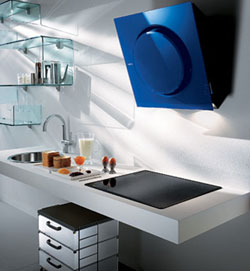Inline Kitchen Ventilation Fan
In most countries, building codes stipulate that each kitchen should be fitted with some form of range ventilation. The reason for this is that kitchens that may not have such devices are generally regarded as health hazards for obvious reasons. One of the ways that such ventilation can be achieved is through the use of an inline kitchen ventilation fan.
This is a form of ventilation that has become very popular over the recent past due to these main reasons:
- It is very convenient.
- It functions quietly without causing any noise pollution.
- It is very effective at removing smoke and other gases from the kitchen environment.
How it works
An inline kitchen ventilation fan works on very simple logics. Basically, it sucks the air out of the kitchen and exhausts it to the outside through an opening in the roof or wall. Such air is conducted through a series of tubes. This is in contrast to basic kitchen fans which simply recirculate air within the kitchen, but don’t necessarily remove it.
The structure of an inline kitchen ventilation fan
A basic inline kitchen ventilation fan has several distinctive features that enable it to work well. The first of these is the hood. This is a funnel-shaped device which is placed over the cooking area and whose function is to act as a receptacle for the steam, grease and smoke. The fact that the hood is located directly over the cooking area means that such gases don’t have a chance to spread to other parts of the kitchen as they are immediately sucked away as soon as they are produced.
Most fans of this type also have a device known as a backdraft damper. This is something which prevents air from the outside from entering the kitchen, which may compromise the functioning of the inline kitchen ventilation fan.
Apart from these two elements, such ventilators also have a fan to suck the air out and a series of ducts to conduct the air from the hood to the outside. The more advanced ventilation fans may also have a silencer to muffle the sound produced by the fan, providing a quieter experience.
Benefits of an inline kitchen ventilation fan
Compared to other forms of ventilation, a good inline kitchen ventilation fan has several unique advantages. For one, such fans are usually very reliable; you are likely to not have to service or replace the inline kitchen ventilation fan for a very long time after initial installation. This is one of the reasons why a lot of people prefer them, since they can just fit them and do not have to bother about maintenance too much.
Apart from that, an inline kitchen ventilation fan also happens to be quieter and thus more energy efficient as compared to other modes of kitchen ventilation. They are therefore more comfortable to use, and also cost less to run as well. Overall, installing one of these in a kitchen would be a very good decision, since they have a lot of benefits that appeal to a wide variety of homeowners.
Categories
- Home
- Kitchen Ventilation Fan Ranges And Styles
- Decorative Range Kitchen Ventilation Fan
- Downdraft Kitchen Ventilation Fan
- Inline Kitchen Ventilation Fan
- Kitchen Stove Ventilation Fan
- Kitchen Ventilation Fan Hood
- Kitchen Ventilation Fan System
- Recirculating Range Kitchen Ventilation Fan
- Kitchen Ventilation Fan Information
- Types Of Kitchen Ventilation Fan
